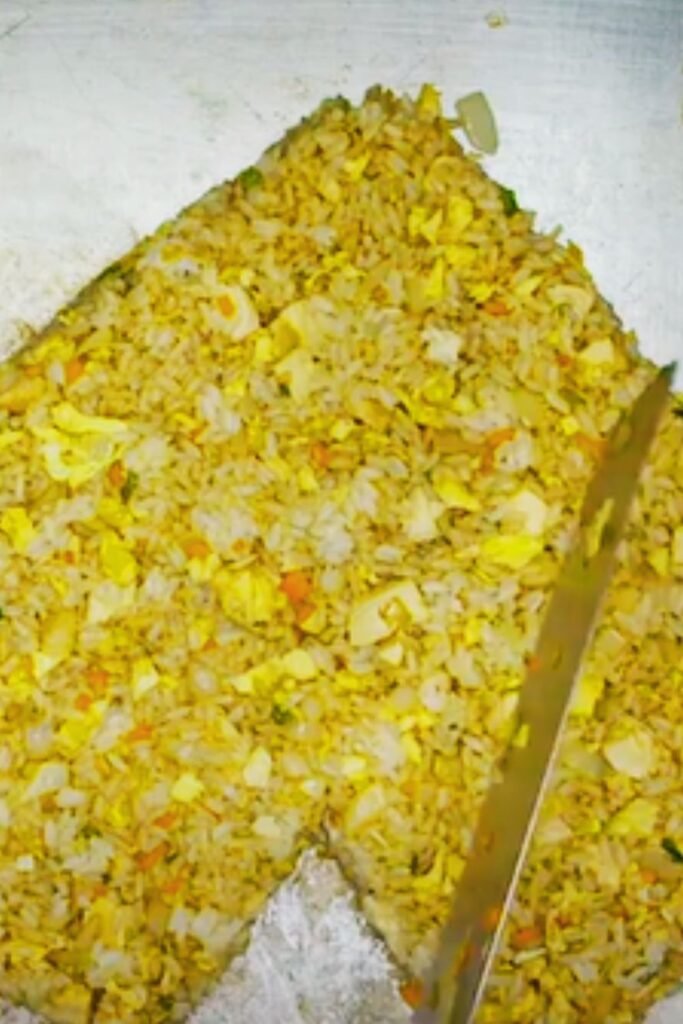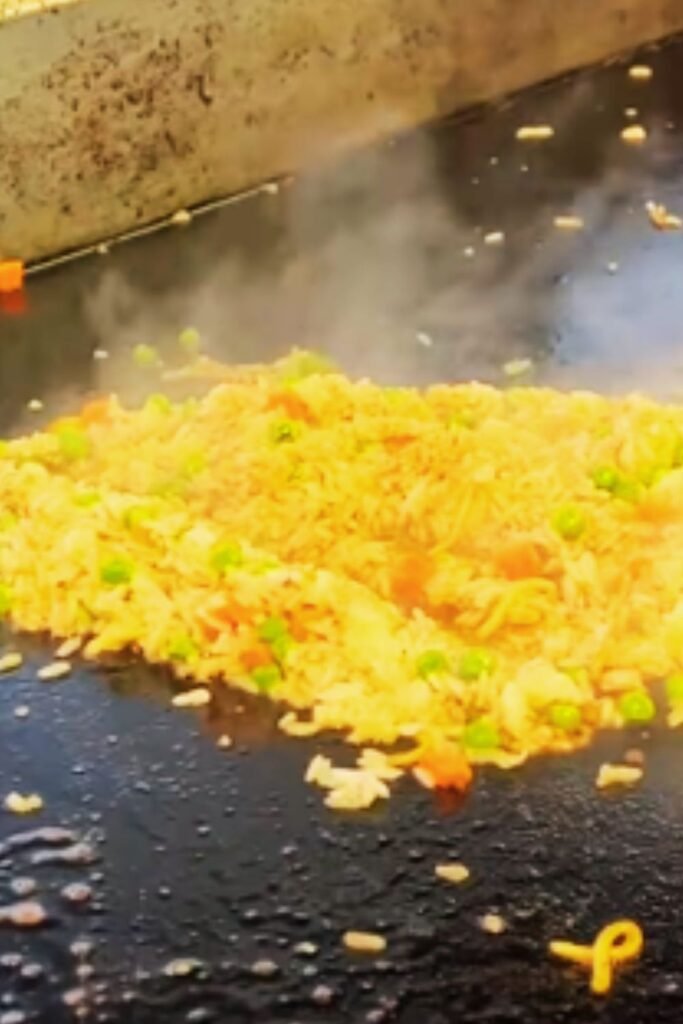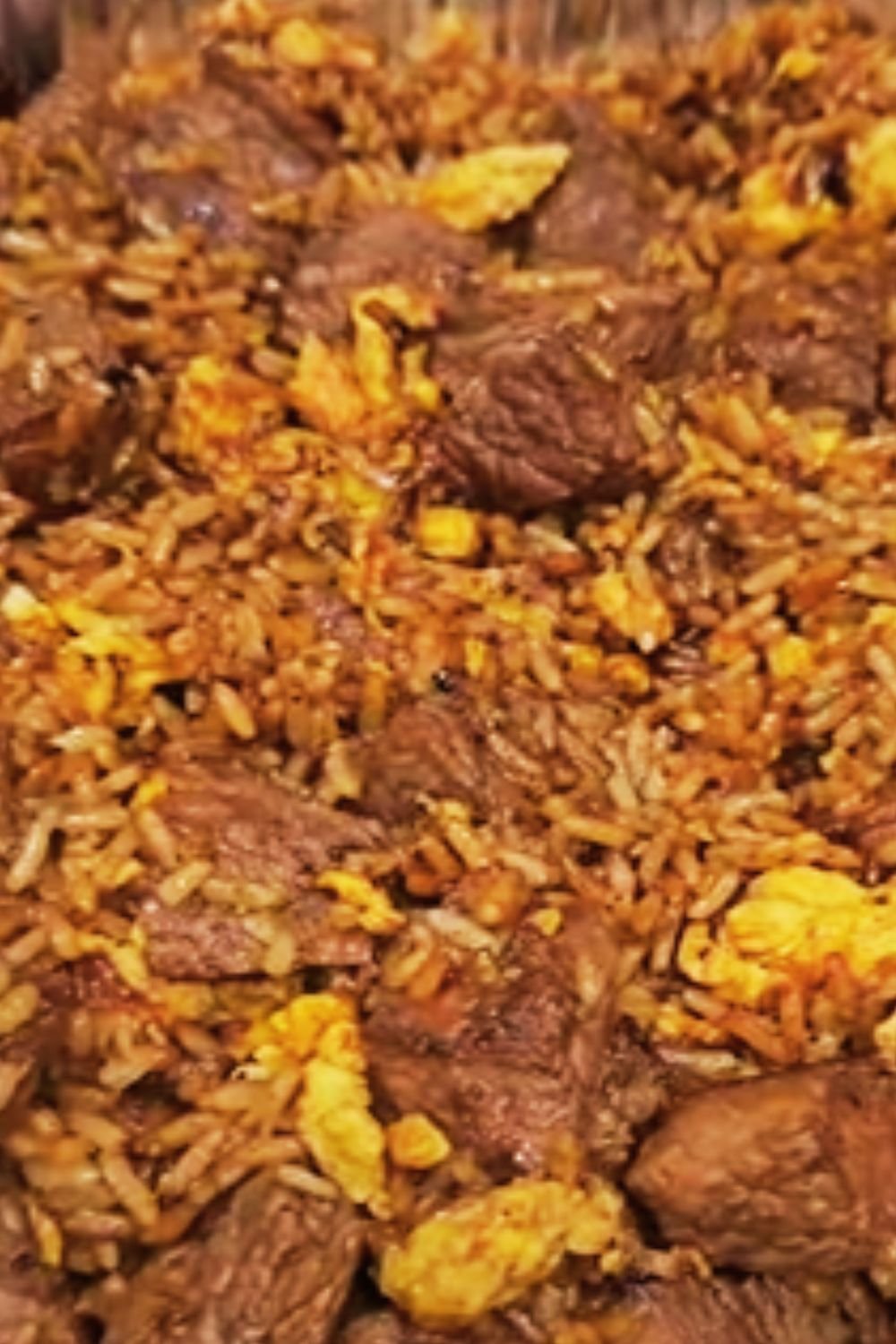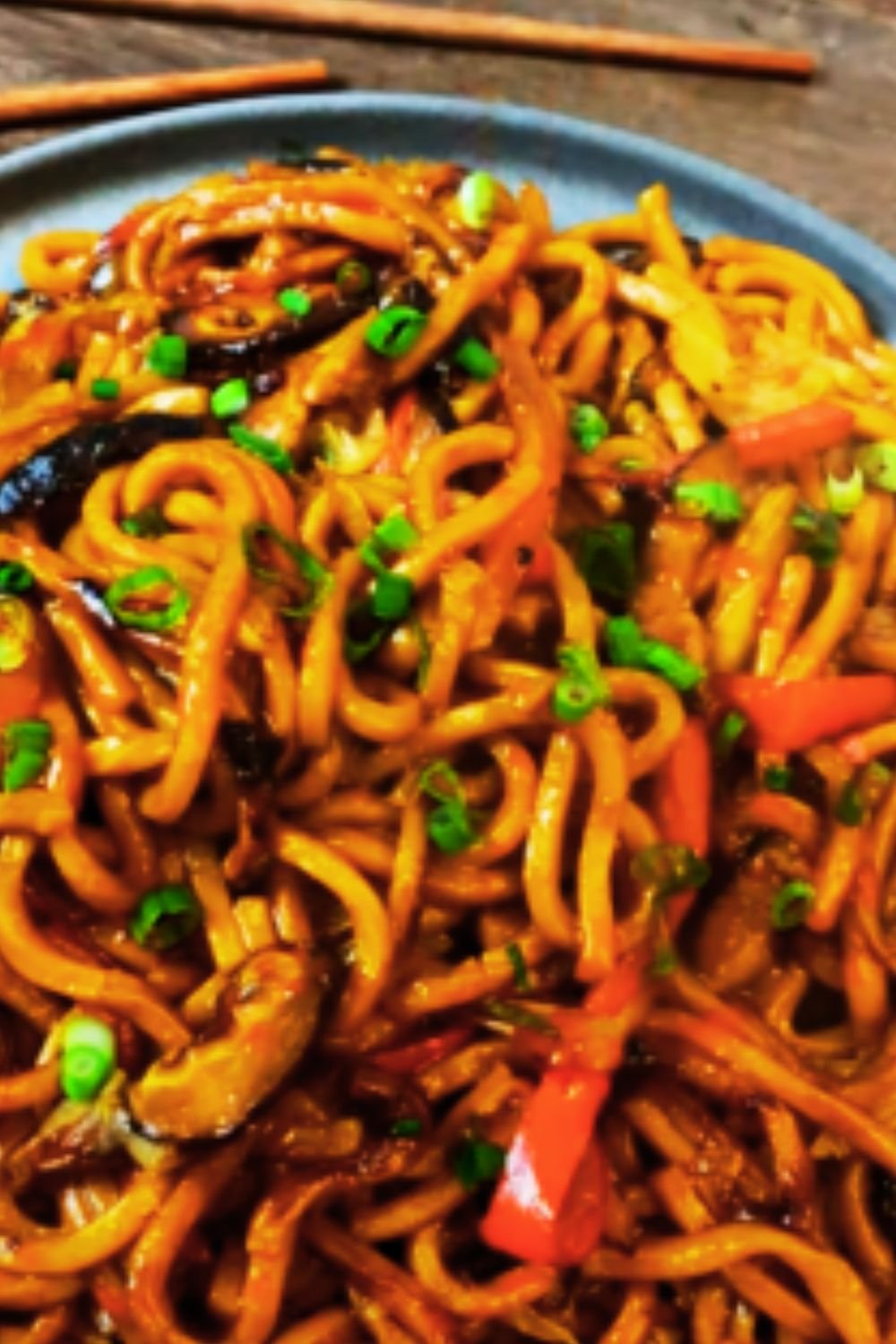There’s something magical about watching a hibachi chef prepare fried rice on a sizzling teppanyaki grill. The theatrical flair, the rhythmic clanging of metal spatulas, and most importantly, that mouthwatering aroma that fills the air. For years, I’ve been obsessed with recreating that perfect hibachi fried rice experience at home, and after countless attempts (and a few memorable failures), I’ve finally mastered the techniques that transform simple ingredients into restaurant-quality hibachi fried rice.
Today, I’m sharing everything I’ve learned about making authentic hibachi fried rice in your own kitchen. Whether you’re looking to impress dinner guests or simply satisfy your craving for Japanese steakhouse flavors without leaving home, this comprehensive guide will take you through every step of the process.
What Makes Hibachi Fried Rice Special?
Before diving into the cooking process, let’s understand what sets hibachi fried rice apart from other varieties. Hibachi-style fried rice is distinguished by its:
- High-heat cooking technique: The intense heat of a teppanyaki grill creates a unique flavor through quick searing.
- Simple but precise seasoning: Usually just soy sauce, butter, and sometimes garlic.
- Perfect rice texture: Individual grains that remain distinct yet tender.
- Minimal but carefully chosen add-ins: Often just eggs, vegetables, and sometimes meat.
The term “hibachi” actually refers to a traditional Japanese heating device, while the flat iron griddle used in Japanese steakhouses is properly called a “teppanyaki” grill. However, in Western countries, “hibachi” has become the common term for this style of cooking.
Essential Ingredients for Perfect Hibachi Fried Rice
To make authentic hibachi fried rice, you’ll need:
The Foundation
- Rice: 4 cups cooked short-grain or medium-grain rice (day-old rice works best)
- Butter: 3 tablespoons (unsalted)
- Soy sauce: 3-4 tablespoons (traditional or low-sodium)
- Sesame oil: 1 tablespoon
The Add-ins
- Eggs: 2 large
- Onion: 1 medium, finely diced
- Carrots: 1/2 cup, diced into small cubes
- Frozen peas: 1/2 cup, thawed
- Green onions: 4-5 stalks, chopped (white and green parts separated)
- Garlic: 2 cloves, minced
Optional Proteins
- Chicken: 1 cup, diced into small pieces
- Shrimp: 1 cup, peeled and deveined
- Beef: 1 cup, thinly sliced (ribeye or sirloin works well)
Seasoning
- Salt: 1/2 teaspoon, or to taste
- White pepper: 1/4 teaspoon (preferred over black pepper for authentic flavor)
- MSG: 1/4 teaspoon (optional, but creates that restaurant flavor)
Equipment You’ll Need
While a professional teppanyaki grill would be ideal, most home cooks can achieve excellent results with:
- A large carbon steel wok or a heavy cast-iron skillet
- Metal spatula or wok tools
- Small bowls for organizing prepped ingredients

Rice Preparation: The Critical First Step
The foundation of excellent hibachi fried rice is, unsurprisingly, the rice itself. Here are my time-tested tips for getting it right:
Choosing the Right Rice
Japanese short-grain or medium-grain rice works best for hibachi fried rice. These varieties contain more starch than long-grain rice, which helps create that sticky-yet-distinct texture that’s characteristic of Japanese fried rice.
Brands I recommend:
- Kokuho Rose
- Nishiki
- Calrose
The Day-Old Rice Secret
Fresh, hot rice will turn mushy when stir-fried. For ideal texture, cook your rice a day ahead and refrigerate it overnight. This allows the rice grains to dry out slightly and firm up, resulting in distinct grains after stir-frying.
If you’re in a hurry, here’s my quick-cooling method:
- Cook rice according to package directions
- Spread cooked rice thinly on a baking sheet
- Place in refrigerator (uncovered) for 1-2 hours
- Break up any clumps with your fingers before using
Perfect Rice Cooking Ratio
For ideal hibachi rice texture, I use this ratio:
- 2 cups uncooked rice
- 2.5 cups water (slightly less than standard cooking instructions)
This creates slightly firmer grains that will hold up better during stir-frying.
The Definitive Hibachi Fried Rice Method
Now let’s get cooking! Follow these steps for authentic hibachi-style fried rice:
Step 1: Prep All Ingredients
The cooking process happens quickly, so having everything prepared and within reach is essential:
- Beat eggs in a small bowl
- Dice all vegetables
- Cut any protein into uniform, bite-sized pieces
- Measure out soy sauce and seasonings
- Have your cooled rice ready, breaking up any clumps
Step 2: Cook Proteins First (If Using)
If adding protein to your fried rice:
- Heat your wok or skillet over high heat until smoking
- Add 1 tablespoon oil
- Cook proteins until just done (2-3 minutes for chicken or beef, 1-2 minutes for shrimp)
- Season lightly with salt and pepper
- Remove and set aside
Step 3: Create the Flavor Base
- Return wok to high heat
- Add 1 tablespoon butter
- Add white parts of green onions and diced onion
- Stir-fry for 30 seconds until fragrant
- Add minced garlic and stir for another 15 seconds (be careful not to burn)
Step 4: Cook the Eggs
- Push vegetables to one side of the wok
- Add 1/2 tablespoon butter to the empty side
- Pour beaten eggs onto the buttered surface
- Let eggs set slightly (about 10 seconds), then scramble gently
- When eggs are about 80% cooked, mix with the vegetables
Step 5: The Main Event – Adding Rice
- Add remaining butter to the wok
- Add cold rice, breaking up any clumps
- Using a chopping and folding motion, stir-fry rice for 2-3 minutes
- Keep everything moving constantly to prevent sticking
- Add carrots and peas, continue stir-frying for 1 minute
Step 6: Season Perfectly
- Drizzle soy sauce around the perimeter of the wok (this helps it caramelize)
- Add white pepper and MSG (if using)
- Stir-fry vigorously to distribute seasonings evenly
- Add sesame oil and toss quickly
- Fold in cooked proteins (if using)
Step 7: Final Touches
- Taste and adjust seasoning if needed
- Add green parts of scallions
- Give a final quick toss
- Remove from heat immediately to prevent overcooking
Troubleshooting Common Hibachi Rice Problems
Even experienced cooks encounter challenges with hibachi rice. Here are solutions to common issues:
| Problem | Cause | Solution |
|---|---|---|
| Rice sticking to wok | Not enough oil or wok not hot enough | Preheat wok properly; use more oil initially |
| Mushy rice | Using freshly cooked rice or overcooked rice | Use day-old rice; undercook rice slightly when preparing |
| Bland flavor | Insufficient seasoning or improper technique | Add soy sauce to hot surfaces; consider small amount of MSG |
| Rice burning | Wok too hot or rice left in one spot too long | Keep rice moving constantly; adjust heat as needed |
| Vegetables too crunchy | Added too late or cooked too briefly | Add dense vegetables earlier in the process |
| Uneven texture | Inconsistent cutting or improper timing | Cut ingredients to uniform sizes; follow cooking order |
Serving Suggestions
Hibachi fried rice works beautifully as both a main dish and a side. Here are my favorite serving ideas:
As a Main Course
- Top with a fried egg for extra richness
- Serve with a side of Japanese pickles or kimchi for brightness
- Pair with a simple miso soup
As a Side Dish
- Accompany with hibachi-style proteins like grilled chicken, steak, or shrimp
- Serve alongside tempura vegetables
- Pair with teriyaki dishes for a complete meal

Variations to Try
Once you’ve mastered the basic technique, try these delicious variations:
Garlic Butter Hibachi Rice
Add 1 extra tablespoon of butter infused with 2 additional cloves of minced garlic.
Spicy Hibachi Rice
Add 1-2 teaspoons of sriracha or sambal oelek during the seasoning stage.
Vegetable-Packed Hibachi Rice
Double the vegetables and add extras like bell peppers, mushrooms, and bean sprouts.
Brown Rice Hibachi
Substitute brown rice for a nuttier flavor and extra fiber (may need slightly more oil).
Storage and Reheating Tips
Hibachi fried rice stores beautifully for quick meals later:
Storage
- Cool completely before refrigerating
- Store in airtight containers
- Keeps well for 3-4 days in the refrigerator
- Can be frozen for up to 2 months in freezer-safe bags
Reheating
For best results when reheating:
- Let refrigerated rice come to room temperature for 10 minutes
- Heat a wok or skillet over medium-high heat
- Add 1 tablespoon oil or butter
- Stir-fry cold rice until heated through (about 3-4 minutes)
- Add a small splash of water if rice seems dry
Health and Nutrition Aspects
Traditional hibachi fried rice is delicious but can be high in sodium and fat. Here are some modifications to make it more nutritionally balanced:
| Original Ingredient | Healthier Alternative | Benefit |
|---|---|---|
| White rice | Brown rice or cauliflower rice | Higher fiber and nutrients |
| 3 tbsp butter | 1 tbsp butter + 1 tbsp oil | Reduced saturated fat |
| Regular soy sauce | Low-sodium soy sauce | Lower sodium content |
| Minimal vegetables | Extra vegetables (2+ cups) | More vitamins and fiber |
| MSG | Extra garlic, ginger, and herbs | Natural flavor enhancement |
A standard serving of hibachi fried rice (approximately 1.5 cups) contains:
- Calories: 350-450
- Carbohydrates: 55-65g
- Protein: 10-15g (more with added protein)
- Fat: 10-15g
- Sodium: 600-900mg
The Cultural Context of Hibachi Cooking
The teppanyaki-style cooking we know as “hibachi” has an interesting history. While many assume it’s an ancient Japanese tradition, the entertainment-focused cooking style actually developed in post-World War II Japan, primarily to appeal to American tourists who were fascinated by the theatrical cooking presentation.
Traditional Japanese hibachi is actually a heating device – a charcoal-filled brazier used for heating rooms and sometimes cooking. The flat iron griddle cooking we associate with hibachi restaurants is properly called teppanyaki, which literally means “iron plate grilling.”
Benihana, founded by Rocky Aoki in 1964, popularized this style of cooking in America. The restaurant chain’s emphasis on chef performance alongside quality food created the hibachi steakhouse experience that many Americans know and love today.

Expert Tips From My Kitchen to Yours
After years of refining my hibachi rice technique, here are my top tips:
- Heat management is crucial: Your pan should be hot enough that rice sizzles on contact, but not so hot that it burns instantly
- Invest in quality tools: A carbon steel wok and proper metal spatulas make a significant difference
- The 80% rule: Cook proteins and eggs to about 80% done before combining with other ingredients – they’ll finish cooking perfectly
- Less is more with soy sauce: You can always add more, but you can’t take it away
- The power of butter: Don’t substitute all the butter for oil – it’s crucial for authentic flavor
- Pay attention to sound: The proper sizzle is an auditory cue that your heat is correct
Frequently Asked Questions
Q: Why does restaurant hibachi rice taste better than homemade?
A: Restaurant hibachi rice benefits from extremely high-heat commercial equipment, well-seasoned cooking surfaces, and chefs with years of experience. To get closer to restaurant results, use day-old rice, ensure your cooking surface is extremely hot before starting, and don’t be shy with butter. Some restaurants also add a small amount of MSG, which enhances flavor dramatically.
Q: Can I make hibachi rice with freshly cooked rice?
A: While day-old rice gives the best texture, you can use fresh rice in a pinch. After cooking, spread it on a baking sheet and place it in the refrigerator (uncovered) for 1-2 hours to dry and cool. It won’t be quite the same as truly day-old rice, but it’s a workable alternative when you’re short on time.
Q: What’s the best cooking oil to use for hibachi rice?
A: For authentic flavor, use a combination of sesame oil and either vegetable or peanut oil. Use the neutral oil (vegetable/peanut) for the initial cooking and add a small amount of sesame oil at the end for flavor. Avoid olive oil, as its flavor profile doesn’t match Japanese cuisine.
Q: Is MSG necessary for authentic hibachi flavor?
A: While not strictly necessary, a small amount of MSG (1/4 teaspoon for a large batch of rice) does create that distinctive restaurant flavor. If you prefer to avoid MSG, you can substitute with a half teaspoon of dashi powder or increase the umami flavor with a splash of fish sauce or additional garlic.
Q: Why do hibachi chefs use so much butter?
A: Butter adds richness, helps prevent sticking, and creates a beautiful caramelization on the rice. It’s also part of what gives hibachi rice its characteristic flavor. While you can reduce the amount for dietary reasons, using at least some butter will give you more authentic results.
Q: Can I make hibachi rice ahead for a party?
A: Yes! Hibachi rice can be made up to a day ahead and reheated. Cook the rice as directed, cool completely, and refrigerate in airtight containers. To reheat, stir-fry in a hot wok with a little oil until heated through. For best flavor, I recommend adding the green onions only after reheating.
Q: How can I get that smoky flavor like at restaurants?
A: The smoky flavor in restaurant hibachi comes from cooking on extremely hot surfaces. To approximate this at home, heat your wok or skillet until it’s smoking before adding any ingredients. Additionally, allowing the soy sauce to hit the hot edges of the pan will create some caramelization that adds to the smoky flavor profile.
Q: What’s the best rice-to-protein ratio for a balanced meal?
A: For a balanced hibachi rice meal, aim for a 2:1 ratio of rice to protein by volume. This typically means about 1 cup of cooked rice to 1/2 cup of protein per serving. Increase the vegetables for a more nutritionally balanced dish.
Final Thoughts: Embracing the Hibachi Experience
Making hibachi fried rice at home isn’t just about recreating a restaurant favorite—it’s about embracing the spirit of hibachi cooking. The precision, the attention to detail, and the understanding of how heat transforms simple ingredients into something extraordinary.
I’ve found that mastering hibachi rice has improved all my stir-fry techniques. The principles of high heat, quick cooking, and careful timing transfer to countless other dishes. Plus, there’s something undeniably satisfying about hearing that perfect sizzle and watching rice transform from simple to spectacular in your own kitchen.
Whether you’re cooking for family, entertaining friends, or simply treating yourself to something special, hibachi fried rice brings a touch of culinary theater to your home. With practice, you’ll develop your own signature tweaks to make this dish uniquely yours.
Give yourself permission to experiment, but always remember the fundamentals: day-old rice, high heat, constant motion, and careful seasoning. Master these elements, and restaurant-quality hibachi rice will be yours to enjoy anytime the craving strikes.


